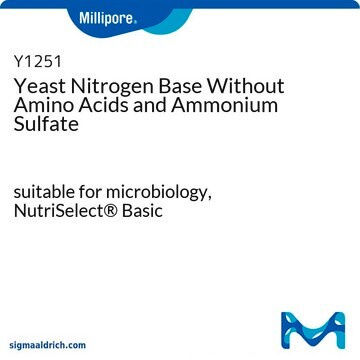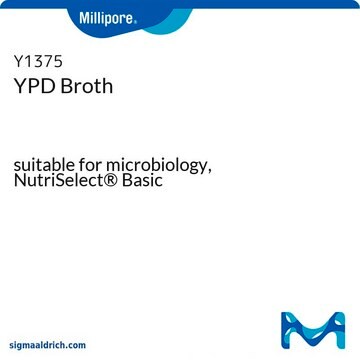Y1501
Yeast Synthetic Drop-out Medium Supplements
without uracil
Synonym(s):
Synthetic drop-out medium for yeast
Sign Into View Organizational & Contract Pricing
All Photos(1)
About This Item
Recommended Products
Looking for similar products? Visit Product Comparison Guide
Application
The selection of plasmids in yeast is based on the use of auxotrophic mutant strains that cannot grow without a specific media component (an amino acid, purine or pyrimidine). Transformation with a plasmid containing the mutated gene enables the transformant to grow on a medium lacking the required component. Sigma′s Yeast Synthetic Drop-Out Media Supplements create a richer medium for better yield and growth rate, and increase the probability of successful transformations when screening libraries or performing gene knock-outs.
Components
The supplements contain all of the following components except as indicated:
Amino acids: All standard amino acids are present at a concentration of 76 mg/L except for leucine, which is present at 380 mg/L.
Other nutrients: Adenine (18 mg/L), inositol (76 mg/L), p-aminobenzoic acid (8 mg/L)
Amino acids: All standard amino acids are present at a concentration of 76 mg/L except for leucine, which is present at 380 mg/L.
Other nutrients: Adenine (18 mg/L), inositol (76 mg/L), p-aminobenzoic acid (8 mg/L)
Other Notes
Mixtures of amino acids and other nutrients to be added to Yeast Nitrogen Base Without Amino Acids.
Quantity
1.92 g will supplement 1 liter of medium.
Storage Class Code
13 - Non Combustible Solids
WGK
WGK 1
Flash Point(F)
Not applicable
Flash Point(C)
Not applicable
Personal Protective Equipment
dust mask type N95 (US), Eyeshields, Gloves
Certificates of Analysis (COA)
Search for Certificates of Analysis (COA) by entering the products Lot/Batch Number. Lot and Batch Numbers can be found on a product’s label following the words ‘Lot’ or ‘Batch’.
Already Own This Product?
Find documentation for the products that you have recently purchased in the Document Library.
Customers Also Viewed
Vinicius Henrique De Oliveira et al.
Ecotoxicology and environmental safety, 202, 110917-110917 (2020-08-18)
Cadmium (Cd) is an extremely toxic environmental pollutant with high mobility in soils, which can contaminate groundwater, increasing its risk of entering the food chain. Yeast biosorption can be a low-cost and effective method for removing Cd from contaminated aqueous
Xiyan Li et al.
PloS one, 10(12), e0146152-e0146152 (2015-12-31)
Metformin, a leading drug used to treat diabetic patients, is reported to benefit bone homeostasis under hyperglycemia in animal models. However, both the molecular targets and the biological pathways affected by metformin in bone are not well identified or characterized.
Dhammika H M L P Navarathna et al.
PloS one, 11(10), e0164449-e0164449 (2016-10-12)
Formation of chlamydospores by Candida albicans was an established medical diagnostic test to confirm candidiasis before the molecular era. However, the functional role and pathological relevance of this in vitro morphological transition to pathogenesis in vivo remain unclear. We compared
Karissa L Cross et al.
mBio, 9(2) (2018-03-15)
The human oral microbiota encompasses representatives of many bacterial lineages that have not yet been cultured. Here we describe the isolation and characterization of previously uncultured Desulfobulbus oralis, the first human-associated representative of its genus. As mammalian-associated microbes rarely have
Hangrui Liu et al.
Biotechnology and bioengineering, 118(2), 647-658 (2020-10-07)
Yeast has been engineered for cost-effective organic acid production through metabolic engineering and synthetic biology techniques. However, cell growth assays in these processes were performed in bulk at the population level, thus obscuring the dynamics of rare single cells exhibiting
Our team of scientists has experience in all areas of research including Life Science, Material Science, Chemical Synthesis, Chromatography, Analytical and many others.
Contact Technical Service












